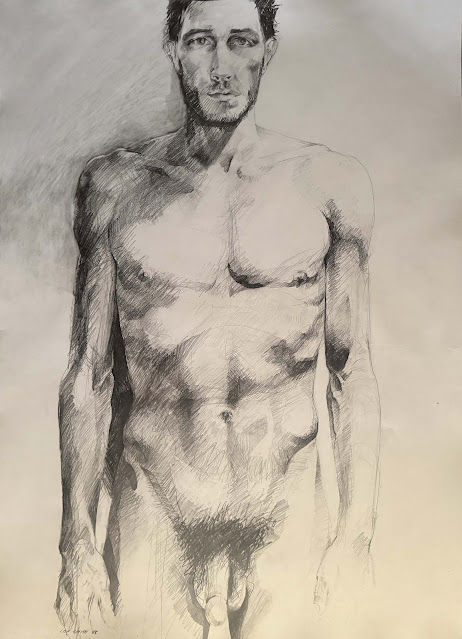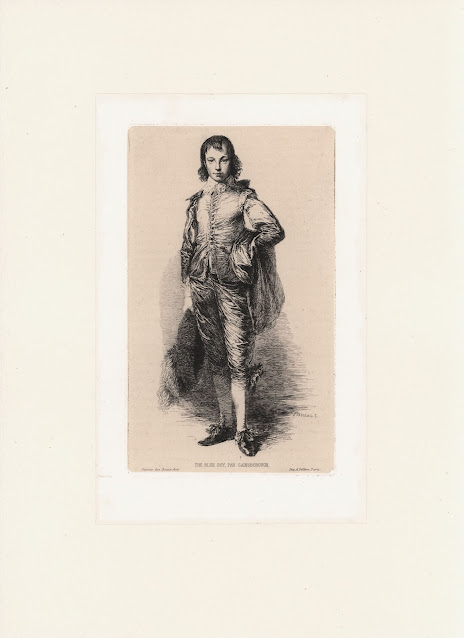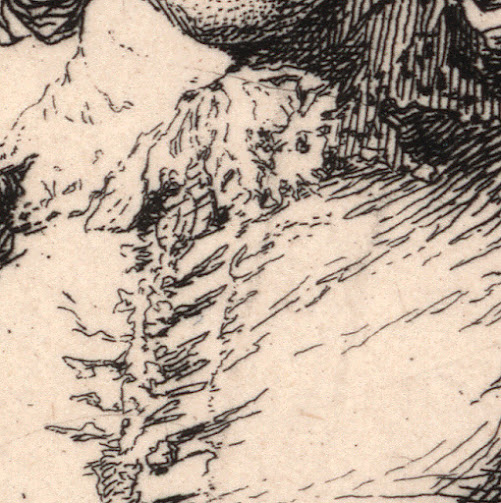Léopold
Flameng (aka Léopold Joseph Flameng) (1831–1911)
“The
Blue Boy, par Gainsborough” (as inscribed in plate), 1862, after Thomas Gainsborough’s (1727–1788)
famous portrait (c.1770) in the Huntington Library, San
Marino (California), first published in “La Gazette des Beaux Arts”, 1862,
vol. 13, and printed by Auguste Delâtre (aka Auguste Marie Delâtre)
(1822–1907) between pages 112 and 113 (see https://archive.org/details/gazettedesbeauxa13pari/page/112/). The plate was republished in c.1890
by Imprimerie Charaire et Cie and printed by Chardon-Wittmann (fl.c.1884–1890)
in Paris, in Teodor de Wyzewa’s “Les Chefs-D'Oeuvre de l'Art au XIXe siècle”,
p. 120 (see https://archive.org/details/leschefsdoeuvred04michuoft/page/120/). This impression is from the earlier
edition.
The fame of
Gainsborough’s painting, reputed to be a portrait of Jonathan Buttall
(1752–1805) dressed in a manner similar to Van Dyck's portrait of
Charles II as a boy in “The Children of King Charles I of England”, 1637, rests
to a large part on it representing a rebuttal of advice (shown below) advocated
by his rival Sir Joshua Reynolds (1723–1792)—founder and first
president of the Royal Academy of Arts:
“It ought, in
my opinion, to be indispensably observed, that the masses of light in a picture
be always of a warm, mellow colour, yellow, red, or a yellowish white, and that
the blue, the grey, or the green colours be kept almost entirely out of these
masses, and be used only to support or set off these warm colours; and for this
purpose, a small proportion of cold colour will be sufficient. Let this conduct
be reversed; let the light be cold, and the surrounding colour warm, as we
often see in the works of the Roman and Florentine painters, and it will be out
of the power of art, even in the hands of Rubens and Titian, to make a picture
splendid and harmonious” (see Ronald Sutherland Gower 1903, “Thomas
Gainsborough”, G. Bell and Sons. pp. 77–78).
Etching on buff
coloured chine collé (China) on heavy wove paper with margins as published.
Size: (sheet) 24.7
x 15 cm; (plate) 22.2 x 11.9 cm; (chine collé) 19.8 x 11.9 cm.
Inscribed on
plate within the image borderline: (lower right) “FLAMENG. S.”
Lettered in
plate along the lower edge: (left) “Gazette des Beaux-Arts.”; (centre)
“THE BLUE BOY, PAR GAINSBOROUGH”; (right) " Imp. A. Delâtre Paris.”
Beraldi 102
(Henri Beraldi 1885, “Les Graveurs du dix-neuvième siècle”, vol. 11, p. 162,
cat. no. 102); IFF 104 (“Inventaire du Fonds Français: Bibliothèque Nationale,
Département des Estampes”, Paris, 1930).
The British
Museum offers a description of this print before lettering with publication
details: https://www.britishmuseum.org/collection/object/P_1895-1015-100.
Condition:
richly inked and well-printed impression with small margins and laid upon an
archival support sheet of millennium quality washi paper providing wide
margins. Beyond a closed tear in the margin at lower left, the sheet is in an
excellent condition with no holes, folds, abrasions or stains.
I am selling
this etching of Gainsborough’s famous portrait by one of the major printmakers
of the 19th century, for the total cost of AU$233 (approximately US$152.56, EUR
130.39 or GBP 112.57), including express mail shipping worldwide. Import
duties, if any, are the responsibility of the buyer.
If you are
interested in purchasing this superb etching showing great insight about using
line to connote space—note, for example, how Flameng has shaded the boy’s
further back leg with horizontal strokes to set it slightly more into the distance and in shadow—please
contact me (oz_jim@printsandprinciples.com) and I will send you a PayPal
invoice to make the payment easy.


























































